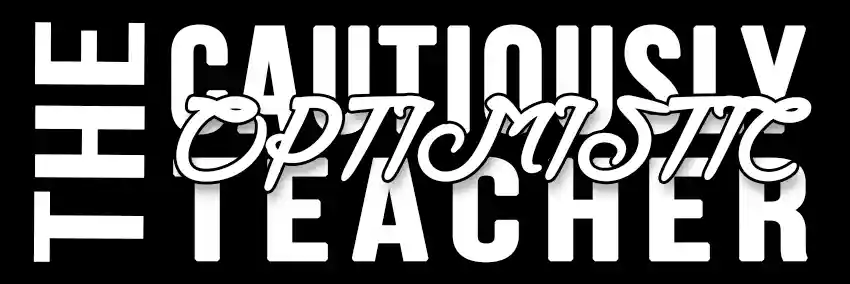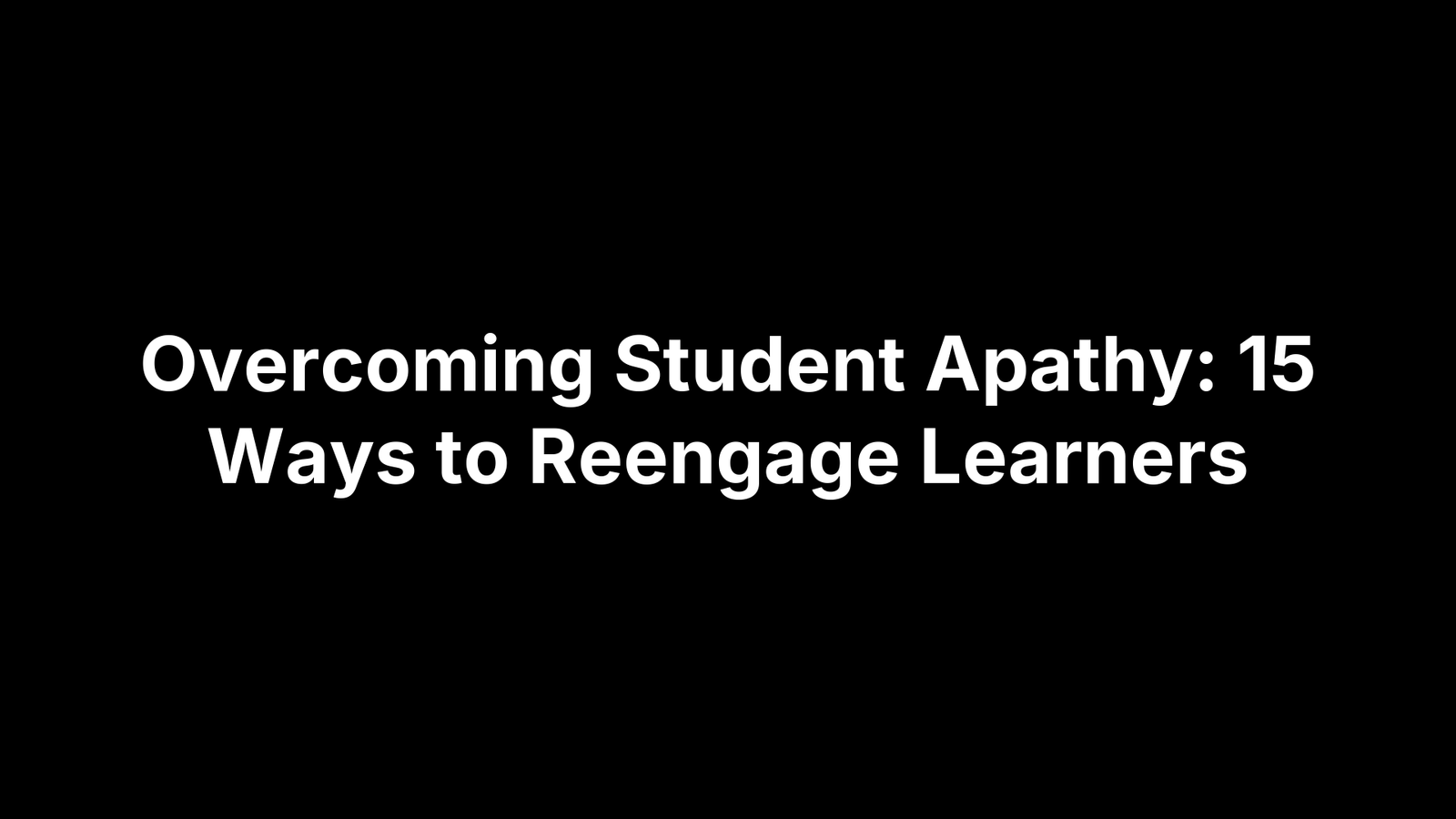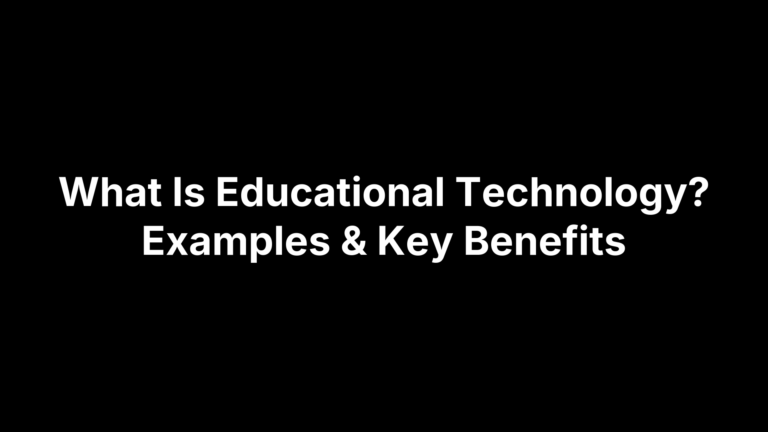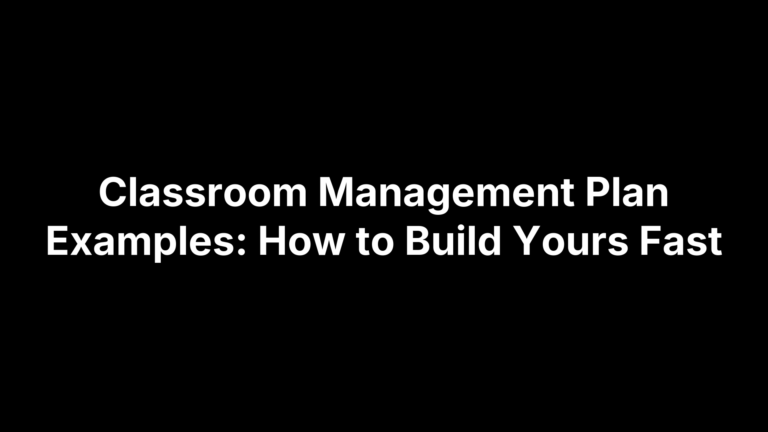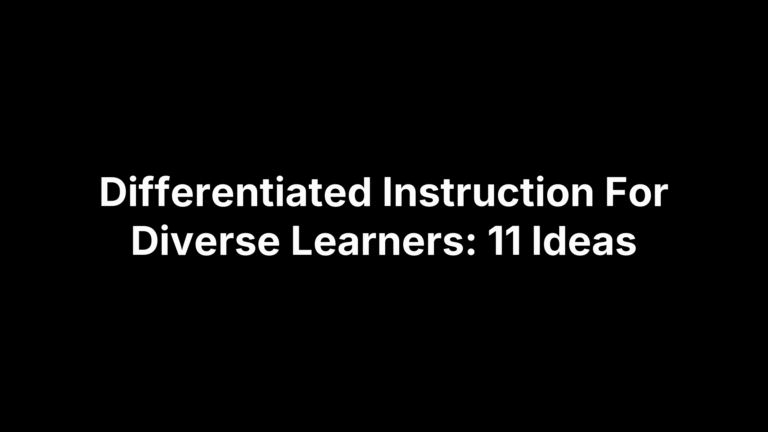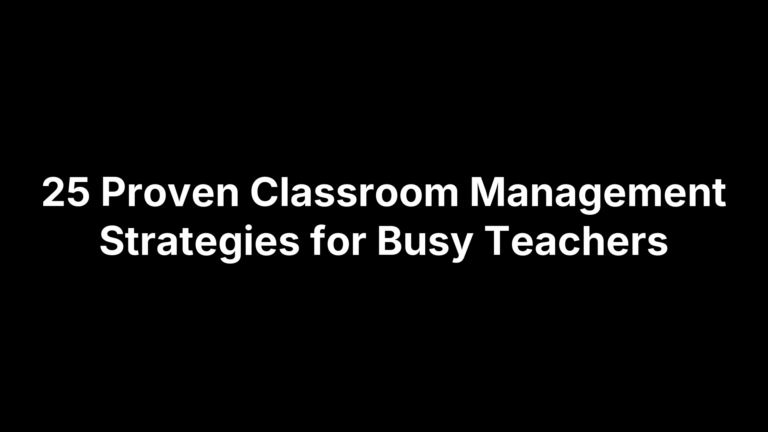15 Ways to Help Reengage Students: Overcoming Student Apathy
Whe a student shrugs at yet another assignment, it signals more than simple boredom—it’s apathy, a protective disengagement that stalls curiosity, lowers achievement, and drains classroom energy. Papers stay blank, discussion falls flat, and even the most dynamic lesson can feel like shouting into the void. The good news: apathy isn’t permanent. Research and day-to-day practice show that targeted moves—personalized tasks, authentic connections, and steady relationships—can switch that protective shell back into genuine drive.
Below, you’ll find 15 classroom-tested strategies designed for quick application. Each entry pairs the “why it works” with the “how to start tomorrow,” so you’re never left guessing. You’ll explore ways to harness AI for differentiation, tap student voice through surveys, weave social-emotional check-ins, partner with families, and even turn everyday lessons into low-prep games. Each strategy arrives with real-class examples, success metrics, and practical tips to dodge common pitfalls. Whether you teach kindergarten literacy or AP physics, the menu offers at least one tactic you can lift and run with during your next planning block. Ready to trade silent stares for purposeful engagement? Let’s jump straight into the playbook.
1. Leverage AI-Powered Differentiation Tools
Even the most carefully planned lesson can miss the mark when every learner sits at a different readiness level. AI takes the guesswork out of matching task to student, giving teachers instant, leveled materials without the weekend grind. Used thoughtfully, these tools turn “one-size-fits-all” into “just-right,” a key lever in overcoming student apathy.
Why This Reengages Learners
- Personalized tasks lower frustration and boredom—two prime drivers of disengagement.
- Adaptive content aligns with UDL principles, letting students access material through preferred modalities.
- Quick success experiences rebuild academic self-efficacy, a proven predictor of sustained motivation.
Action Steps for Teachers
- Open The Cautiously Optimistic Teacher’s Differentiated Instruction Helper.
- Enter tomorrow’s objective and choose three proficiency bands.
- Auto-generate leveled readings, practice items, and scaffolded hints.
- Use the Worksheet Maker or Question Generator to fill skill gaps you spot on the fly.
- Vet for accuracy and cultural responsiveness—edit as needed.
- Deploy in class, then log exit-ticket data into the Report Card Commentor to track growth and craft specific feedback.
- Repeat the cycle weekly; the five-minute setup frees planning time for deeper instruction.
Classroom Example
During an 8th-grade persuasive essay unit, Ms. J generated three texts on school lunch reform at Lexile 800, 950, and 1100. Students self-selected a level, used AI-created sentence starters, and re-entered discussion confident and prepared—participation jumped from 48 % to 79 % in one period.
Tips & Pitfalls
- Start with a single lesson to avoid tech overload.
- Always preview AI output for bias, outdated info, or jargon.
- Pair digital resources with human check-ins; relationships, not robots, keep momentum alive.
2. Diagnose Root Causes with Student Voice Surveys
Apathy is a symptom, not the illness. A quick, anonymous survey—repeated every few weeks—can reveal why students are zoning out: relevance gaps, stress, unclear directions. When learners notice their feedback shaping lessons, they move from passengers to co-pilots.
Because apathy often masquerades as laziness, assumptions run wild. A survey replaces guesswork with data you can use: maybe 70 % don’t see real-world value, or half are caring for siblings after school. Knowing the “why” lets you pick the right fix instead of piling on rewards or consequences that miss the mark.
Why This Reengages Learners
- Feeling heard satisfies belonging needs, unlocking academic risk-taking.
- Data targets precise barriers instead of one-size fixes.
- Publicly sharing results builds trust and momentum.
Step-by-Step Implementation
- Build a 10-item Google or Microsoft Form (6 Likert, 3 multiple choice, 1 open-ended).
- Cover interest, obstacles, and learning modes; finish in under five minutes.
- Administer every 4–6 weeks; guarantee anonymity with an opt-out code.
- Share one slide next class: “You said ___; so we’re trying ___.”
- Re-ask key items next round to track impact.
Sample Survey Questions
- “Which topic felt useful this week?”
- “What blocks your focus most often?”
- “Pick a learning mode for next unit: video, text, audio, hands-on.”
- “How confident are you starting homework alone?”
- Likert scale: “I belong in this class.”
3. Build Trust Through Consistent Relationships
Apathy often masks self-protection: “If I don’t care, I can’t fail.” The fastest way to melt that armor is through daily, predictable interactions that prove the classroom is a safe place to take academic risks. When students believe the adult at the front sees them as whole people, they lean in, ask questions, and even admit confusion—critical milestones in overcoming student apathy.
The Role of Teacher-Student Relationships
Maslow reminds us that belonging precedes achievement. A student whose relational needs are unmet can’t fully access higher-order thinking, no matter how dazzling the lesson. Consistency signals belonging: same greeting, same tone, same follow-through. Over time, that reliability rewires expectations—“My effort matters here,”—which in turn fuels engagement.
Daily Routines that Foster Trust
- Door greetings with name plus eye contact
- Two-minute desk check-ins while others start a warm-up
- Restorative language (“What happened?”) instead of punitive labels (“Why didn’t you?”)
- Class norms co-written with students and revisited after conflicts
- Predictable feedback cycles—assign, comment, confer, revise
Measuring Progress
Create a simple tracker for one month:
- Voluntary comments during discussion
- On-time homework submissions
- Anecdotal notes on student mood or initiative
An uptick in any metric signals that relational deposits are paying off—and that renewed engagement is within reach.
4. Make Learning Relevant with Real-World Connections
Nothing torpedoes curiosity faster than the question, “When will we ever use this?” If students can’t picture a practical payoff, worksheets feel pointless and apathy creeps in. Mapping lessons to authentic situations flips the script: content becomes a tool for solving problems they actually care about, and effort suddenly carries obvious value. Even a modest tweak—like swapping textbook data for neighborhood statistics—can reignite interest and set the stage for deeper inquiry.
Why Relevance Matters
- Cognitive science shows prior knowledge anchors new learning; real-life hooks supply that anchor.
- Relevance addresses a top PAA query, “How to reverse student apathy?” by answering the classic “So what?”
- Tangible applications build self-efficacy: students see themselves using the skill, which fuels persistence.
Practical Strategies
- Begin with a headline: tie today’s objective to a current event or viral trend.
- Use the “So what?” test: after planning an activity, ask how it benefits life outside class—revise if the answer is fuzzy.
- Invite community experts for five-minute video shout-outs explaining how they use the skill on the job.
- Let students supply examples via a quick Padlet wall; integrate their submissions into guided practice.
Quick Win Examples
- Algebra: Compare fixed vs. variable APR on actual teen bank accounts.
- Biology: Track local air-quality index and predict asthma risk.
- History: Conduct oral interviews with family members about immigration journeys and plot them on a shared GIS map.
Connecting coursework to lived experience turns “Why bother?” into “What’s next?”—a pivotal move in overcoming student apathy.
5. Offer Choice and Autonomy in Assignments
Giving students real choices transforms compliance into ownership. When learners steer the route—topic, format, or pacing—they’re more likely to invest effort and creativity. Strategic autonomy, not free-for-all chaos, is a proven lever for overcoming student apathy.
Psychological Foundations
Self-Determination Theory says motivation takes off when autonomy, competence, and relatedness line up. A simple “pick your tool” option satisfies autonomy, while tiered rubrics preserve competence. Brain imaging studies even show choice activates the ventromedial prefrontal cortex, the reward hub—scientific backup for why autonomy flips the engagement switch.
Ways to Embed Choice
- Choice boards with must-do, can-do, and extension items let students set their own challenge level.
- Homework menus: pick three out of five tasks, each tapping a different modality (video summary, comic strip, data set analysis).
- Playlist learning paths in Google Sheets: required checkpoints anchor progress while optional detours encourage curiosity.
- “You pick 2” assessments: essay, podcast, infographic, or live demonstration.
Classroom Management Considerations
Frame freedom with guardrails. Provide clear success criteria, mini-lesson checkpoints, and short reflection prompts (“Why did you choose this format? How did it help you?”). Rotate conferencing time to spot early drift and keep rigor intact.
6. Gamify Lessons to Spark Intrinsic Motivation
When class feels like a level-grind instead of an adventure, disengagement sets in fast. Wrapping objectives inside familiar game mechanics flips effort into entertainment, triggering the same dopamine burst students chase in their favorite apps. Done right, gamification turns practice problems into quests and formative checks into boss battles—no fancy coding required.
Game Elements That Work
- Points and experience bars to visualize progress toward mastery
- Tiered levels that unlock harder challenges once prerequisites are met
- Storylines or avatars that let students role-play content experts
- Hidden “Easter eggs” that reward curiosity and thorough reading
- Opt-in leaderboards or team scores for a cooperative competitive edge
Low-Prep Gamification Tools
- Kahoot! or Blooket for instant, arcade-style quizzes
- Classcraft to layer RPG elements over daily routines
- Google Sheets XP tracker with conditional formatting as a live scoreboard
- Physical badge stickers or digital badges via Canva for tangible recognition
Sample Gamified Unit Plan
In a three-week “Time-Travel Quest,” history students became era-hopping agents. Completing inquiry tasks earned artifact cards; collecting five artifacts unlocked a virtual “boss battle” debate. Attendance jumped 12 %, and even quiet learners scrambled to level up before the final showdown.
7. Set High Expectations and Provide Timely Feedback
Academic rigor and rapid feedback form a one-two punch for overcoming student apathy. When students see that you believe they can tackle challenging work—and get actionable guidance before frustration sets in—they interpret difficulty as a surmountable puzzle rather than proof they “just aren’t good at school.”
Impact on Apathy
A clear, demanding learning target communicates trust in students’ ability. Combine that with 24- to 48-hour feedback cycles and you ignite the motivation loop:
- Try a tough task
- Receive specific notes while the effort is fresh
- Revise and experience quick growth
That visible progress triggers dopamine and reinforces persistence, shrinking the gap between effort and reward.
Feedback Techniques
- “Praise, Probe, Polish”: open with one concrete success, ask a thought-provoking question, finish with a precise next step.
- Audio comments via Mote or Canva Record to add tone, saving typing time and boosting clarity.
- Five-minute desk conferences during independent work; use a sticky note checklist so students leave with a tangible action plan.
- Color-coded Google Doc highlights: green = strength, yellow = clarify, red = revise, making patterns obvious at a glance.
Avoiding Common Traps
High expectations must travel with scaffolds—graphic organizers, exemplars, sentence stems—or rigor morphs into discouragement. Likewise, feedback that’s vague (“Good job”) or late (next unit) feels irrelevant. Keep comments specific, actionable, and timely, and watch apathy pivot to authentic engagement.
8. Integrate Collaborative Learning and Peer Teaching
Few forces smash through disengagement faster than a well-run team task. Working with classmates adds accountability, exposes students to new perspectives, and shifts the teacher from the single source of knowledge to a coach. In the process, reluctant learners often discover that their own explanations, questions, or “aha” moments matter to someone else—a subtle but powerful step toward overcoming student apathy.
Why Collaboration Reengages Learners
Peer interaction checks three motivation boxes at once—belonging, competence, and autonomy. Explaining a concept to a classmate cements understanding (the protégé effect) while hearing multiple voices normalizes struggle and success. Social stakes also raise the likelihood that every student will prepare and participate.
Structures to Try
- Jigsaw: each group masters one slice of content, then re-teaches it to peers.
- Think-Pair-Share: rapid, low-prep discussion that warms up quieter students.
- Peer tutoring “expert tables”: rotating help desks for targeted skills.
- Gallery walks: stations with posters or Google Slides, sticky-note feedback at each stop.
Managing Group Dynamics
Set rotating roles—facilitator, recorder, skeptic, presenter—to balance workload. Use a simple participation tracker (✓, Δ, ✕) for on-task behavior, and model accountable-talk stems like “I’d like to build on that idea …”. Debrief afterward so groups refine processes, not just products.
9. Use Social-Emotional Learning to Address Well-Being
Apathy is often misread as laziness; more often it’s self-preservation. Students battling stress, anxiety, or shaky self-worth disengage to avoid more pain. The PAA query “What causes student apathy?” cites these factors. A brief, daily dose of social-emotional learning (SEL) equips learners with language and tools to regulate emotions, set goals, and bounce back—prerequisites for academic risk-taking. Embedding SEL inside regular lessons, not as an add-on, keeps content moving while signaling that feelings matter.
SEL Practices
- 60-second mindful or box breathing drills pre-assessment
- Emoji slide check-in; students drag mood icon, teacher follows up quietly
- Growth-mindset reframes: swap “I can’t” for “I can’t yet” on rubrics
- Two-word gratitude journal during bell ringer to prime optimism
- Role-play giving/receiving feedback to build empathy
Resources and Scheduling
Slot SEL into 5–10-minute starters: Monday mindfulness, Wednesday gratitude, Friday goal check. Free resources like CASEL’s competency wheel, Mood Meter apps, or printable self-talk cards cut prep. Connect reflections to content (“Describe which coping skill helped you solve today’s lab error”) so emotional literacy and academics reinforce each other.
10. Utilize Short, Brain-Activating Movement Breaks
A body that sits still for an entire class period sends the same sleepy signal to the brain. Quick movement bursts reset attention, pump oxygen to working memory centers, and make the next chunk of instruction feel fresh rather than punishing. Even two minutes away from the desk can chip away at the glazed-over look that often accompanies student apathy.
Neuroscience Behind Movement
Research shows light activity increases cerebral blood flow and releases neurotransmitters like dopamine and norepinephrine—both tied to alertness and recall. In practical terms, a 60-second stretch can improve on-task behavior as much as a longer recess, but without destroying pacing.
Easy Brain Break Ideas
- “Would You Rather?” stand/sit decisions tied to lesson content
- Desk-side yoga poses or shoulder rolls
- 30-second dance party to a student-chosen clean track
- Content scavenger hunt: locate three circles in the room, then solve a geometry provocation
- Cross-lateral marches while reciting vocab
- Silent freeze-frame charades of historical figures
Timing and Transitions
Aim for a reset every 20–25 minutes, using a visual timer and a consistent cue phrase (“Recharge!”). Train students to return materials to ready position before the countdown ends; the predictability preserves momentum while the movement restores mental bandwidth.
11. Celebrate Small Wins to Reinforce Effort
Disengaged students often feel trapped in a cycle of failure. Break that loop by spotlighting tiny, observable gains—finishing a warm-up, asking a clarifying question, revising one paragraph. Frequent, bite-sized recognition rewires expectations from “Why try?” to “My work matters.”
The Power of Recognition
Micro-celebrations trigger dopamine, the brain’s reward chemical, building a feedback loop that links effort with positive emotion. Over time, those moments of acknowledgment snowball into greater self-efficacy and resilience, two antidotes to apathy.
Celebration Methods
- Class “shout-out” wall: students post sticky notes praising peer progress.
- Digital badges in Google Classroom for milestone mastery.
- Surprise positive emails or calls home highlighting a single improvement.
- Sticker charts tracking process goals (e.g., on-time drafts, collaboration).
- One-minute victory song when the whole class beats a formative-assessment benchmark.
Ensuring Authenticity
Praise the specific behavior, not the person: “You added evidence in your second draft—nice revision hustle,” beats “You’re smart.” Vary recognition so it feels earned, and invite students to nominate peers, ensuring celebrations stay genuine rather than routine.
12. Embed Technology Students Already Use
Scrolling TikTok, recording voice notes, dropping memes in group chats—these tools occupy hours of students’ lives, yet they’re often banned at school. Repurposing familiar apps for academic tasks turns a “guilty pleasure” into a bridge back to learning, a sneaky but effective step in overcoming student apathy. Comfort with the interface lowers the cognitive load, so mental energy can shift toward the actual content.
Meeting Learners Where They Are
When the medium feels second nature, students focus on message over mechanics. A 30-second vertical video recap of a lab hits the same dopamine loop as their For You page, but now the algorithm is your rubric. Plus, letting students showcase digital talents validates identities often invisible in traditional assignments.
Ideas for Integration
- Instagram-style “photo essays” analyzing symbolism in a novel
- Podcast debates recorded with built-in phone mics, shared via QR codes
- TikTok-length math explainer clips capped at 60 seconds
- Interactive polls or word clouds through Mentimeter to preview background knowledge
- Collaborative Google Jamboard where each slide equals one frame of a history timeline
Digital Citizenship Reminders
Model ethical sharing: cite sources in captions, blur faces when needed, and discuss how algorithms shape perception. Build a quick checklist—credit, consent, context—so creativity thrives without compromising safety.
13. Implement Project-Based Learning Driven by Student Interests
When students co-design a long-term inquiry around topics they nerd out about—fashion sustainability, esports economics, neighborhood water quality—apathy yields to curiosity. Project-based learning (PBL) channels that passion into standards, giving even chronic hand-raisers a reason to lean forward.
Why PBL Works for Disengaged Students
- Provides purpose and audience, two elements often missing when apathy shows up.
- Invites real-world problem solving and iterative drafts, so persistence is rewarded over one-shot grades.
- Builds interdisciplinary skills—research, collaboration, media literacy—letting every talent shine.
Designing a Successful PBL Unit
- Craft a driving question that can’t be Googled: “How might our town cut cafeteria waste by 50 %?”
- Poll interests, then vote; shared buy-in shrinks off-task behavior.
- Map standards to milestones: inquiry, prototype, community feedback, showcase.
- Deliver minilessons “just in time,” not all at once.
- Secure a real audience—city council, Reddit AMA, younger grades—to raise stakes.
Assessment and Reflection
- Co-create rubrics covering content, process, impact.
- Hold mid-project peer critiques with “Glow/Grow” stems.
- End with a public exhibition plus a reflection: “What moment flipped my motivation?”
Check-ins keep rigor high while choice stays intact—a recipe for overcoming student apathy.
14. Engage Parents and Caregivers as Accountability Partners
Even the most creative lesson loses traction if the adults at home send a different message about effort or attendance. Turning parents and caregivers into allies extends the classroom’s reach, adds another layer of accountability, and gives students a united support team. The goal isn’t more homework policing; it’s synchronizing expectations so learners hear a single, encouraging chorus: “Your growth matters.”
Family Involvement and Motivation
Research links family engagement to higher grades, better behavior, and improved attendance—all antidotes to apathy. Share the “why” behind upcoming units, not just the due dates. When caregivers understand the purpose of a Socratic seminar or coding project, they’re more likely to ask probing questions at the dinner table and celebrate progress, fueling intrinsic motivation.
Communication Channels
- Weekly “peek ahead” newsletter with one success story and next steps
- Remind or ClassDojo texts for quick kudos or clarification
- 90-second video updates that model key strategies (e.g., how to annotate a text)
- Positive phone calls before concerns arise, establishing a collaborative tone
Strategies for Hard-to-Reach Families
Offer flexible meeting windows, from early-morning Google Meet drop-ins to evening community-center pop-ups. Translate materials, enlist bilingual student ambassadors, and partner with local liaisons who already have families’ trust. By lowering logistical and linguistic barriers, you invite every caregiver into the engagement circle.
15. Reflect and Iterate Using Formative Assessment Data
Even the strongest engagement strategy flops if you can’t tell whether it’s working. Treat every lesson like a prototype: collect real-time evidence, study the results, and tweak before the next class period. A steady diet of low-stakes checks keeps instruction responsive and shows students their input reshapes the course—an underrated lever in overcoming student apathy.
Data-Driven Mindset
Think of formative data as headlights, not rear-view mirrors. Instead of waiting for unit tests, scan for misunderstandings and motivation dips while learning is still malleable. Share that purpose up front so students see assessments as shared problem-solving, not gotchas.
Quick Assessment Techniques
- Exit tickets with one content question plus “How confident do you feel?”
- Traffic-light cards (green/yellow/red) flashed after a mini-lesson
- Four-question digital quizzes in Google Forms that auto-graph trends
- One-sentence summaries on sticky notes clustered by accuracy
- Emoji sliders in Pear Deck to gauge energy and clarity
Closing the Loop
Review patterns during prep, then open the next class with “Yesterday’s data showed ___, so today we’ll ___.” Post a side-by-side chart of misconceptions vs. adjusted activities to make growth visible. The public feedback cycle builds trust, signals that effort drives change, and motivates students to keep feeding you honest data.
Keep the Momentum Going
You now have fifteen concrete strategies ready to deploy. Each hinges on the same trio—personalization, relevance, and relationship-building. Keep those pillars in mind and you’ll spot countless micro-opportunities to transform passive faces into active learners. Consistency, not perfection, is what sustains engagement over the long haul.
Try this cadence:
- Pick one strategy that matches an upcoming lesson—no massive overhaul required.
- Set a simple metric (exit-ticket score, participation tally, survey mood) and collect baseline data.
- Revisit after a week, refine, then layer in a second approach when ready.
Small wins compound quickly; within a month, the class culture starts tilting toward curiosity. For more ready-made resources, including the free AI Differentiation Helper, swing by The Cautiously Optimistic Teacher and keep the momentum rolling.
